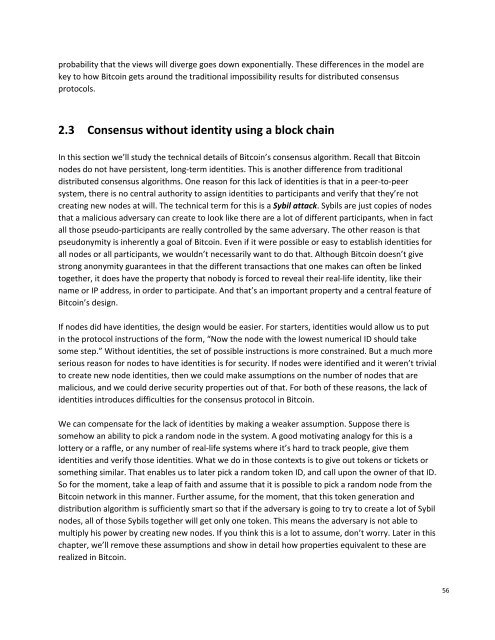Bitcoin and Cryptocurrency Technologies
1Qqc4BN
1Qqc4BN
Create successful ePaper yourself
Turn your PDF publications into a flip-book with our unique Google optimized e-Paper software.
probability that the views will diverge goes down exponentially. These differences in the model are<br />
key to how <strong>Bitcoin</strong> gets around the traditional impossibility results for distributed consensus<br />
protocols.<br />
2.3 Consensus without identity using a block chain<br />
In this section we’ll study the technical details of <strong>Bitcoin</strong>’s consensus algorithm. Recall that <strong>Bitcoin</strong><br />
nodes do not have persistent, long‐term identities. This is another difference from traditional<br />
distributed consensus algorithms. One reason for this lack of identities is that in a peer‐to‐peer<br />
system, there is no central authority to assign identities to participants <strong>and</strong> verify that they’re not<br />
creating new nodes at will. The technical term for this is a Sybil attack. Sybils are just copies of nodes<br />
that a malicious adversary can create to look like there are a lot of different participants, when in fact<br />
all those pseudo‐participants are really controlled by the same adversary. The other reason is that<br />
pseudonymity is inherently a goal of <strong>Bitcoin</strong>. Even if it were possible or easy to establish identities for<br />
all nodes or all participants, we wouldn’t necessarily want to do that. Although <strong>Bitcoin</strong> doesn’t give<br />
strong anonymity guarantees in that the different transactions that one makes can often be linked<br />
together, it does have the property that nobody is forced to reveal their real‐life identity, like their<br />
name or IP address, in order to participate. And that’s an important property <strong>and</strong> a central feature of<br />
<strong>Bitcoin</strong>’s design.<br />
If nodes did have identities, the design would be easier. For starters, identities would allow us to put<br />
in the protocol instructions of the form, “Now the node with the lowest numerical ID should take<br />
some step.” Without identities, the set of possible instructions is more constrained. But a much more<br />
serious reason for nodes to have identities is for security. If nodes were identified <strong>and</strong> it weren’t trivial<br />
to create new node identities, then we could make assumptions on the number of nodes that are<br />
malicious, <strong>and</strong> we could derive security properties out of that. For both of these reasons, the lack of<br />
identities introduces difficulties for the consensus protocol in <strong>Bitcoin</strong>.<br />
We can compensate for the lack of identities by making a weaker assumption. Suppose there is<br />
somehow an ability to pick a r<strong>and</strong>om node in the system. A good motivating analogy for this is a<br />
lottery or a raffle, or any number of real‐life systems where it’s hard to track people, give them<br />
identities <strong>and</strong> verify those identities. What we do in those contexts is to give out tokens or tickets or<br />
something similar. That enables us to later pick a r<strong>and</strong>om token ID, <strong>and</strong> call upon the owner of that ID.<br />
So for the moment, take a leap of faith <strong>and</strong> assume that it is possible to pick a r<strong>and</strong>om node from the<br />
<strong>Bitcoin</strong> network in this manner. Further assume, for the moment, that this token generation <strong>and</strong><br />
distribution algorithm is sufficiently smart so that if the adversary is going to try to create a lot of Sybil<br />
nodes, all of those Sybils together will get only one token. This means the adversary is not able to<br />
multiply his power by creating new nodes. If you think this is a lot to assume, don’t worry. Later in this<br />
chapter, we’ll remove these assumptions <strong>and</strong> show in detail how properties equivalent to these are<br />
realized in <strong>Bitcoin</strong>.<br />
56









